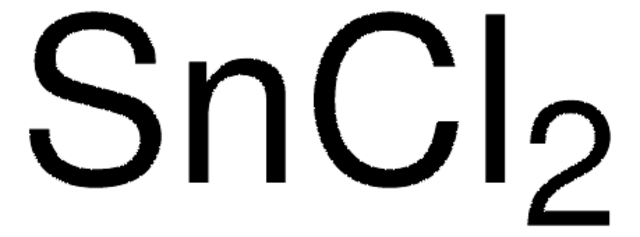467901
Nickel(II)-sulfat Hexahydrat
≥99.99% trace metals basis
About This Item
Empfohlene Produkte
Qualität
for inorganic trace analysis
Qualitätsniveau
Dampfdichte
2.07 (vs air)
Assay
≥99.99% trace metals basis
Form
solid
Verunreinigungen
≤0.002% N compounds
≤0.005% insolubles
<100 ppm total metallic impurities
Anionenspuren
chloride (Cl-): ≤0.001%
Kationenspuren
Ca: ≤0.005%
Co: ≤0.002%
Cu: ≤0.005%
Fe: ≤0.001%
K: ≤0.01%
Mg: ≤0.005%
Mn: ≤0.002%
Na: ≤0.05%
SMILES String
O.O.O.O.O.O.[Ni++].[O-]S([O-])(=O)=O
InChI
1S/Ni.H2O4S.6H2O/c;1-5(2,3)4;;;;;;/h;(H2,1,2,3,4);6*1H2/q+2;;;;;;;/p-2
InChIKey
RRIWRJBSCGCBID-UHFFFAOYSA-L
Suchen Sie nach ähnlichen Produkten? Aufrufen Leitfaden zum Produktvergleich
Allgemeine Beschreibung
Anwendung
- Improvement of ion chromatography with ultraviolet photometric detection and comparison with conductivity detection for the determination of serum cations.: This study explores advanced ion chromatography techniques for analyzing serum cations, where Nickel(II) sulfate hexahydrate may be used as a standard or in method development. The research compares ultraviolet photometric detection with conductivity detection, enhancing analytical methods for precise cation analysis in various samples, which can be crucial for environmental and clinical chemistry (Shintani H, 1985).
Signalwort
Danger
Gefahreneinstufungen
Acute Tox. 4 Inhalation - Acute Tox. 4 Oral - Aquatic Acute 1 - Aquatic Chronic 1 - Carc. 1A Inhalation - Muta. 2 - Repr. 1B - Resp. Sens. 1 - Skin Irrit. 2 - Skin Sens. 1 - STOT RE 1 Inhalation
Zielorgane
Respiratory Tract
Lagerklassenschlüssel
6.1D - Non-combustible acute toxic Cat.3 / toxic hazardous materials or hazardous materials causing chronic effects
WGK
WGK 3
Flammpunkt (°F)
Not applicable
Flammpunkt (°C)
Not applicable
Analysenzertifikate (COA)
Suchen Sie nach Analysenzertifikate (COA), indem Sie die Lot-/Chargennummer des Produkts eingeben. Lot- und Chargennummern sind auf dem Produktetikett hinter den Wörtern ‘Lot’ oder ‘Batch’ (Lot oder Charge) zu finden.
Besitzen Sie dieses Produkt bereits?
In der Dokumentenbibliothek finden Sie die Dokumentation zu den Produkten, die Sie kürzlich erworben haben.
Kunden haben sich ebenfalls angesehen
Unser Team von Wissenschaftlern verfügt über Erfahrung in allen Forschungsbereichen einschließlich Life Science, Materialwissenschaften, chemischer Synthese, Chromatographie, Analytik und vielen mehr..
Setzen Sie sich mit dem technischen Dienst in Verbindung.












